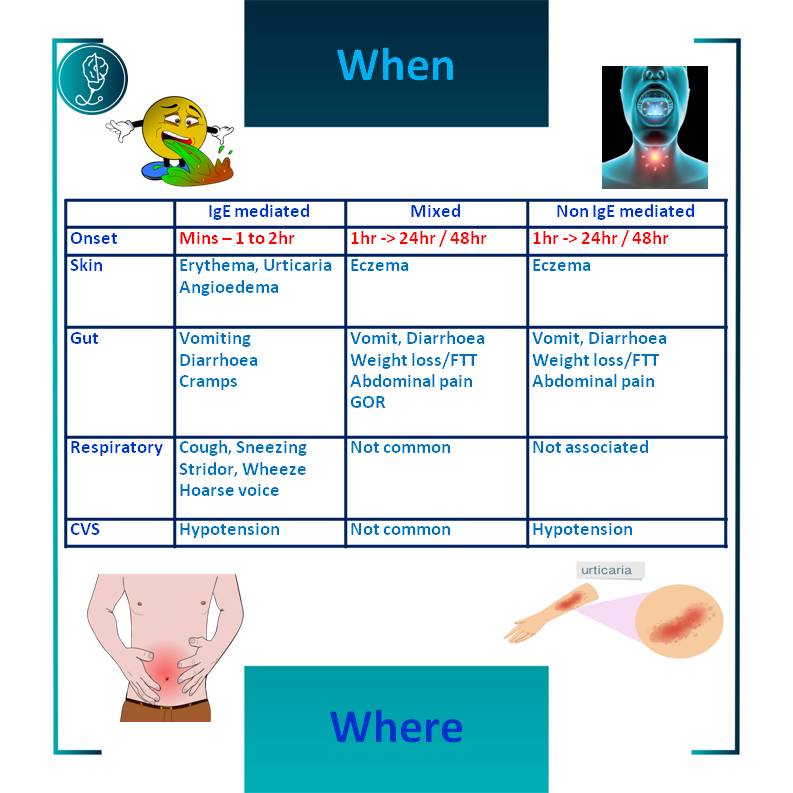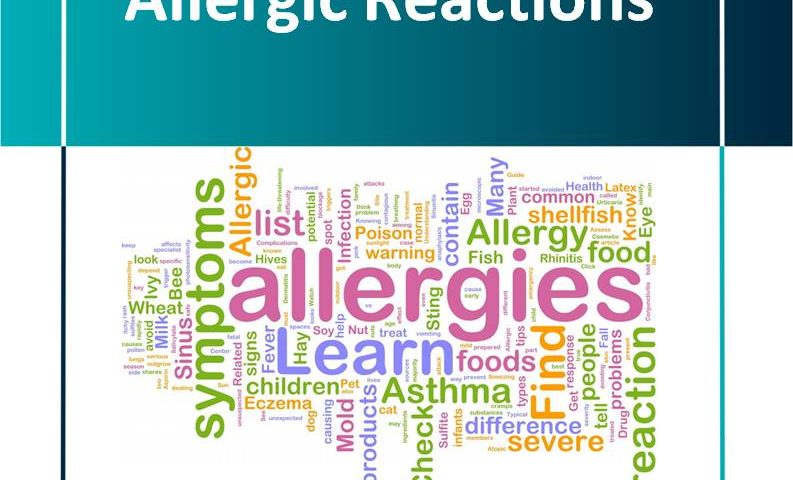Allergic reactions

Weaning a child into solids
09/01/2023
Public Transport and Allergic Reactions
16/01/2023In normal conditions, our immune system is used to protect us against viruses and bacteria.
If there is either no development of tolerance or that tolerance vanishes, the immune system turns against those proteins (allergens) and reacts.
𝗪𝐡𝐚𝐭 𝐚𝐫𝐞 𝐭𝐡𝐞 𝐜𝐨𝐦𝐦𝐨𝐧 𝐚𝐥𝐥𝐞𝐫𝐠𝐞𝐧𝐬?
- 𝘍𝘰𝘰𝘥𝘴 - peanuts, tree nuts, finned fish, shellfish, eggs, milk, soy, and wheat.
- 𝘓𝘢𝘵𝘦𝘹 𝘢𝘯𝘥 𝘧𝘰𝘰𝘥𝘴 𝘤𝘳𝘰𝘴𝘴 𝘳𝘦𝘢𝘤𝘵𝘪𝘯𝘨 𝘸𝘪𝘵𝘩 𝘪𝘵 (These foods include banana, kiwi, chestnut, avocado, pineapple, passion fruit, apricot, and grape )
- 𝘈𝘯𝘪𝘮𝘢𝘭 𝘥𝘢𝘯𝘥𝘦𝘳
- 𝘗𝘭𝘢𝘯𝘵𝘴 𝘢𝘯𝘥 𝘱𝘰𝘭𝘭𝘦𝘯𝘴
- 𝘋𝘶𝘴𝘵 𝘮𝘪𝘵𝘦𝘴
- 𝘔𝘰𝘭𝘥
𝐓𝐡𝐞𝐫𝐞 𝐚𝐫𝐞 𝐭𝐰𝐨 𝐦𝐚𝐢𝐧 𝐫𝐞𝐚𝐜𝐭𝐢𝐨𝐧𝐬 𝐚𝐬𝐬𝐨𝐜𝐢𝐚𝐭𝐞𝐝 𝐰𝐢𝐭𝐡 𝐭𝐡𝐞𝐦.
- 𝘛𝘺𝘱𝘦 𝘐 (𝘪𝘮𝘮𝘦𝘥𝘪𝘢𝘵𝘦 𝘳𝘦𝘢𝘤𝘵𝘪𝘰𝘯𝘴) – 𝘐𝘨𝘌 𝘮𝘦𝘥𝘪𝘢𝘵𝘦𝘥
- An initial sensitisation is needed before a reaction can occur.
- The immune system considers the allergen as an “invader” and seeks to destroy it by using IgE, which leads to the release (among others) of histamine.
- Histamine then causes blood vessels to increase in size, which in association with other chemicals, leads to allergy symptoms.
- 𝘛𝘺𝘱𝘦 𝘐𝘝 (𝘥𝘦𝘭𝘢𝘺𝘦𝘥 𝘳𝘦𝘢𝘤𝘵𝘪𝘰𝘯𝘴) – 𝘯𝘰𝘯-𝘐𝘨𝘌 𝘮𝘦𝘥𝘪𝘢𝘵𝘦𝘥
- Reactions to food protein are likely due to an immature immune system of the gut mucosa. They are mediated by T Cells.
- This is the most common kind of allergy in the first few years of life.
- As it takes several hours between ingestion and symptoms to show, it tends to go under recognised, leading to significant parental frustration.

The Symptoms depend on what the allergen is and the type of reactions.
- They vary from very mild to life-threatening (Anaphylaxis and FPIES – which I will talk about in another post).
- The ones below are IgE mediated but have a look at the table for signs of delayed reactions.
𝐅𝐨𝐨𝐝 𝐚𝐥𝐥𝐞𝐫𝐠𝐢𝐞𝐬:
- Mouth tingling
- Swelling of lips, face, tongue, or throat
- Hives
- Vomiting and/or diarrhoea
- Sometimes flare-up of eczema
- Wheeze, stridor, difficulty breathing (𝐀𝐧𝐚𝐩𝐡𝐲𝐥𝐚𝐱𝐢𝐬)
- Altered conscious state (𝐀𝐧𝐚𝐩𝐡𝐲𝐥𝐚𝐱𝐢𝐬)
- Hypotension (𝐀𝐧𝐚𝐩𝐡𝐲𝐥𝐚𝐱𝐢𝐬)
𝐀𝐥𝐥𝐞𝐫𝐠𝐢𝐜 𝐫𝐡𝐢𝐧𝐢𝐭𝐢𝐬:
- Sneezing
- Itchy, blocked or runny nose
- Itchy, red, watery eyes (allergic conjunctivitis)
- Itchy mouth
- Flare-up of eczema
𝐌𝐞𝐝𝐢𝐜𝐚𝐭𝐢𝐨𝐧:
- Swelling of lips, face, tongue, or throat
- Hives
- Vomiting and/or diarrhoea
- Wheeze, stridor, difficulty breathing (𝐀𝐧𝐚𝐩𝐡𝐲𝐥𝐚𝐱𝐢𝐬)
- Altered conscious state (𝐀𝐧𝐚𝐩𝐡𝐲𝐥𝐚𝐱𝐢𝐬)
- Hypotension (𝐀𝐧𝐚𝐩𝐡𝐲𝐥𝐚𝐱𝐢𝐬)
𝐈𝐧𝐬𝐞𝐜𝐭 𝐬𝐭𝐢𝐧𝐠𝐬:
- Swelling at the sting site, which can spread rapidly
- Hives or itching throughout your body
- Wheeze, stridor, difficulty breathing (𝐀𝐧𝐚𝐩𝐡𝐲𝐥𝐚𝐱𝐢𝐬)
- Altered conscious state (𝐀𝐧𝐚𝐩𝐡𝐲𝐥𝐚𝐱𝐢𝐬)
- Hypotension (𝐀𝐧𝐚𝐩𝐡𝐲𝐥𝐚𝐱𝐢𝐬)


